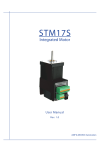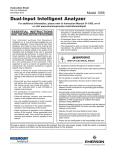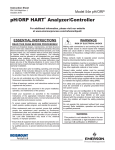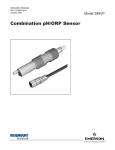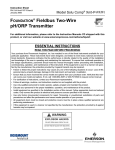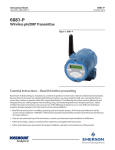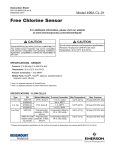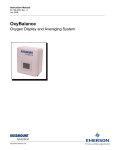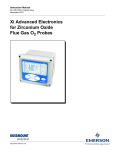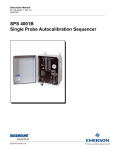Download Emerson 228 Stud Sensor User Manual
Transcript
Instruction Sheet PN 51A-228/rev.P December 2010 Model 228 Submersion/Insertion Toroidal Sensor For additional information, please visit our website at www.emersonprocess.com/raihome/liquid/. CAUTION WARNING CAUTION SENSOR/PROCESS APPLICATION COMPATIBILITY The wetted sensor materials may not be compatible with process composition and operating conditions. Application compatibility is entirely the responsibility of the user. Before removing the sensor, be absolutely certain that the process pressure is reduced to 0 psig and the process temperature is lowered to a safe level! SPECIFICATIONS - SENSORS * MODEL Wetted Materials Temperature Pressure CRN pressure* 228-02 228-03 228-04 228-05 PEEK (glass-filled) PEEK (glass-filled) Tefzel (glass-filled) Tefzel (unfilled) 248°F (120°C) 392°F (200°C) 248°F (120°C) 248°F (120°C) 295 psig (2135 kPa abs) 295 psig (2135 kPa abs) 200 psig (1480 kPa abs) 200 psig (1480 kPa abs) 220 psig (1618 kPa abs) 220 psig (1618 kPa abs) 150 psig (1135 kPa abs) 150 psig (1135 kPa abs) Maximum pressure for applications requiring CRN registration SPECIFICATIONS - RETRACTION ASSEMBLIES Operating Conditions PN 23311-00 (mechanical) 23311-01 (manual) Wetted Materials 316 SS, Teflon, EPDM 316 SS, Teflon, EPDM 316 SS, Teflon, EPDM Temperature 392°F (200°C) 392°F (200°C) Pressure 295 psig (2135 kPa abs) 295 psig (2135 kPa abs) Retraction/Insertion Conditions Temperature 392°F (200°C) 266°F (130°C) Pressure 295 psig (2135 kPa abs) 35 psig (343 kPa abs) SPECIFICATIONS - ADAPTERS * PN Wetted Materials Temperature Pressure CRN pressure* 23242-02 23242-03 2001990 2001990 PEEK, Viton, 316 SS PEEK, Viton, 316 SS CVPC, PEEK, Viton CVPC, PEEK, Viton 392°F (200°C) 392°F (200°C) 100°F (38°C) 185°F (85°C) 295 psig (2135 kPa abs) 295 psig (2135 kPa abs) 100 psig (791 kPa abs) 45 psig (412 kPa abs) 220 psig (1618 kPa abs) 220 psig (1618 kPa abs) NA NA Maximum pressure for applications requiring CRN registration MODEL 228 FIGURE 1. Adapter PN 23242-02 use with 228-21 (3/4 in. MNPT) INSTALLATION FIGURE 2. Adapter PN 23242-03 use with 228-20 (5/8-11 UNC threads) FIGURE 3. Adapter PN 2001990 use with 228-21 (3/4 in. MNPT) INSTALLATION Keep at least 1 in. (2.5 cm) between the sensor and pipe walls. If the clearance is too small, calibrate the sensor in place. Ensure that the sensor is completely submerged in liquid. Mounting the sensor in a vertical pipe run with the flow from bottom to top is best. If the sensor must be mounted in a horizontal pipe run, orient the sensor in the 3 o’clock or 9 o’clock position. WIRING Keep sensor wiring away from ac conductors and high current demanding equipment. Do not cut cable. Cutting the cable may void the warranty. FIGURE 4. Wire Functions 2 MODEL 228 WIRING FIGURE 5. Wiring 228-54 and 228-56 sensors to Model 1056 and 56 analyzers FIGURE 6. Wiring 228-54 and 228-56 sensors to Model 54eC analyzer 3 MODEL 228 WIRING FIGURE 7. Wiring 228-54 and 228-56 sensors to Model Xmt-T panel mount transmitter FIGURE 8. Wiring 228-54 and 228-56 sensors to Model Xmt-T pipe/wall mount transmitter 4 MODEL 228 WIRING DSHLD CLEAR DSHLD DRV A WHITE WHITE BLACK GREEN BLACK CLEAR WHITE GREEN DRV A SHLD BLACK RSHLD DRV B SHLD RSHLD DRV B CLEAR RTD IN RCV A RTD IN GREEN RCV A RCV B SENSE BLACK SENSE TB1 BLACK RCV B RTN TB2 RTN CLEAR TB1 GREEN WHITE TB2 CLEAR CLEAR SHIELD IS NOT CONNECTED. IT IS PRESENT IN HIGH TEMPERATURE (OPTION-03) ONLY 228-56 228-54 FIGURE 9. Wiring 228-54 and 228-56 sensors to Model 1066 transmitter FIGURE 10. Wiring 228-54 and 228-56 sensors to Model 5081-T transmitter 5 MODEL 228 WIRING WIRING THROUGH A REMOTE JUNCTION BOX FIGURE11. Wiring sensors through a remote junction box Wire sensors point to point. For wiring at the analyzer end, refer to the appropriate analyzer wiring diagram. For interconnecting cable 23294-00, use the 2265-54 wiring diagram. For interconnecting cable 23294-04 and 23294-05, use the 226-56 wiring diagram. FIGURE 12. Remote Junction Box (PN 23550-00) 6 MODEL 228 USE OF INSERTION - RETRACTION ASSEMBLIES INSERTION - RETRACTION ASSEMBLIES INSTALLATION REQUIREMENTS 1. Process connection: 1-1/2 inch. Larger openings may keep the sensor from inserting far enough into the process liquid. 4. Retraction clearance: 2 ft (0.6 m). 2. Line size: 3 in.; 2-in. line requires in-place calibration. 6. Flush water: provide 1/8 in. valves in inlet and outlet flush ports. Position flush ports so that retraction chamber can be drained. 3. Valve: 1-1/2 NPT full port ball valve (PN 9340065). 5. Provide mechanical support if excess vibration is expected. MANUAL RETRACTION ASSEMBLY (PN 23311-01) INSTALLATION 1. Loosen the collet nut and retract the sensor tube into the retraction chamber. See Figure 14. 2. Loosen the union nut and separate the retraction chamber from the assembly. 3. Install the retraction chamber on the 1-1/2 in. NPT full port ball valve mounted on the process line or vessel. 4. Thread the sensor cable through the tube into the junction box. Screw the sensor into the tube. Hand tighten the sensor an additional half turn once the gasket is seated. 5. Connect the sensor and interconnecting cable leads to the terminal strip in the junction box. See figure 13. 6. Connect the other end of the cable to the analyzer. See the wiring diagrams in Figures 5 through 10. For cable PN 23294-00 follow the wiring for the 228-54 sensor. For cable PN 23294-04 and 23294-05, follow the wiring for the 228-56 sensor, with the following exception: Refer to the wire function diagram for the 228-56 option in figure 4 and identify the RTD wire bundle. Connect the RTD wires to the analyzer as follows: Green – RTD in Black – no connection Clear – RTD common or RTD return White – RTD sense Wrap the bare end of the black wire to prevent accidental connections. 7. Insert the sensor and tube assembly into the retraction chamber. 8. Tighten the union nut. 9. Open the ball valve, check for leaks, and manually insert the sensor into the process. 10. Position the sensor at least 1/2 in. (13 mm) away from any wall of the vessel or pipe. 11. Tighten the collet nut. 23294-00 (For cables 23294-04 and 23294-05, see note) FIGURE 13. Sensor-Mounted Junction Box Wiring Note: Interconnecting cables PN 23924-04 and 23294-05 have four RTD (TC) leads: clear, black, white, and green. Do not connect the black RTD (TC) lead. Cable PN 23294-05 has a clear outer shield. See Figure 11. Do not connect the outer shield. 7 MODEL 228 USE OF INSERTION - RETRACTION ASSEMBLIES RETRACTION 1. Make certain that the system pressure is less than 35 psig (342 kPa abs). Push in on the sensor using the top of the junction box. Slowly loosen the collet nut. MILLIMETER INCH WARNING Severe impact injury can occur if the collet nut is loosened under pressure. 2. When the collet nut is loose enough, slowly ease the sensor back so that it clears the ball valve. Close the valve to the process line. 3. Drain the retraction chamber contents using the 1/8 in. flush ports. 4. Loosen the 3 in. hex union nut. Remove the sensor and tube assembly. 5. Replace the 3 in. hex nut O-ring. Place the sensor and tube assembly back in the retraction assembly. Tighten the 3 in. hex union nut. Verify that the 1/8 in. flush ports are closed. NOTE With the ball valve closed and the retraction chamber 1/8 in. flush ports open, some residual process fluid may leak from the 3 in. hex union nut female ACME threads. This leakage is normal and to be expected. 6. Before opening the ball valve, make sure that the process pressure is less than 35 psig (342 kPa abs). Open the ball valve and check for leaks. Insert the sensor into the process. Tighten the collet nut. WARNING Retraction chamber contents may be under pressure. FIGURE 14. Manual Retraction Assembly 8 MODEL 228 USE OF INSERTION - RETRACTION ASSEMBLIES MECHANICAL RETRACTION ASSEMBLY (PN 23311-00) INSTALLATION 1. Thread the sensor cable through the tube into the junction box. Screw the sensor into the tube. Hand tighten the sensor an additional half turn once the gasket is seated. See Figure 15. 2. Terminate the sensor wiring in the junction box. See Figure 13 for wiring details. 3. Using a 1/2 in. (13 mm) socket wrench, retract the sensor into the retraction chamber. 4. Install the assembly on the 1-1/2 in. NPT full port ball valve mounted in the process line or vessel. 5. Tighten the union nut. 6. Open the ball valve and check for leaks. 7. Using a 1/2 in. (13 mm) socket wrench, insert the sensor into the process line or vessel. 8. Position the sensor at least 1/2 in. (13 mm) away from any wall of the vessel or pipe. Set the travel stop collar “A” next to the nut housing. MILLIMETER INCH WARNING Do not loosen cap screws or collar when pressurized. RETRACTION 1. Make certain that the system pressure is less than 295 psig (2135 kPa abs) before retracting the sensor. 2. Retract the sensor using a 1/2 in. (13 mm) socket wrench. When the sensor clears the ball valve, close the valve. WARNING Retraction chamber contents may be under pressure. 3. Drain the retraction chamber contents using the 1/8 in. flush ports. 4. Loosen the 3 in. hex union nut, and remove the retraction stop collar and orange clamp top. Remove the sensor and tube assembly. 5. Replace the 3 in. hex nut O-ring. Place the sensor and tube assembly back in the retraction assembly. Replace the retraction stop collar about 1/2 in. in front of the clamp. Tighten the clamp screws, retraction stop collar, and 3-in. hex union nut. Verify that the 1/8 in. flush ports are closed. NOTE With the ball valve fully closed and the retraction chamber 1/8 in. flush ports open, some residual FIGURE 15. Mechanical Retraction Assembly process fluid may leak from the 3 in. hex union nut female ACME threads. This leakage is normal and to be expected. 6. Before opening the ball valve, make sure that the process pressure is less than 295 psig (2135 kPa abs). Open the valve, check for leaks, and insert sensor into the process. 9 MODEL 228 USE OF INSERTION - RETRACTION ASSEMBLIES REPLACING SEALS IN MANUAL AND MECHANICAL RETRACTION ASSEMBLIES. 1. Retract the sensor into the retraction chamber and fully close the ball valve. 2. Drain the retraction chamber contents using the 1/8 in. flush ports. WARNING 14. Rebuild the bushing housing. The open end of the cup seal (spring visible) faces the process. Retraction chamber contents may be under pressure. 15. Carefully slide the bushing housing onto the sensor tube. Do not damage the Teflon bushing or the Teflon cup seal. 3. (Mechanical) Mark the location of the nut housing cap and retraction collar on the sensor tube. Remove both socket head cup screws from the nut housing and loosen the retraction stop collar. 16. (Manual) Slide the 3 in. Hex Union nut, collet nut with nut guard, junction box compression nut, and plastic ferrules onto the sensor tube. 4. Remove the 3 in. Hex Union nut. 5. Withdraw the sensor from the retraction chamber. 17. (Mechanical) Slide the 3 in. Hex Union nut, retraction stop collar, junction box compression nut, and plastic ferrules onto the sensor tube. 6. Open the junction box and disconnect the sensor wires from the terminal block. 7. Remove the compression fitting just below the junction box and remove the junction box from the sensor tube. 18. Connect the junction box to the sensor tube and wire the sensor leads to the appropriate terminals. 8. (Manual) Pull down the nut guard and remove the collet nut from the bushing housing. 20. Place the Union nut O-ring on the bottom of the bushing housing. Insert the sensor assembly into the retraction chamber and tighten the 3 in. Hex Union nut. 9. Slide all hardware including the bushing housing off the sensor tube. 10. Remove the retaining ring from the bottom of the bushing housing. 11. Remove the Teflon guard. 12. From the top of the bushing housing press out the Teflon bushing. This will also push out the Teflon cup seal. 10 13. Replace all damaged parts with replacement parts from Figure 16 or 17. Replace the sensor tube if the surface is damaged. A rough or uneven surface will prevent the Teflon cup from sealing. 19. (Mechanical) Lock the retraction stop collar into position (see Figure 15 or previously marked position for proper location). 21. (Mechanical) Install the nut housing cap (see Figure 15 or previously marked position for proper location). MODEL 228 USE OF INSERTION - RETRACTION ASSEMBLIES FIGURE 16. Mechanical Retraction Assembly Replacement Parts 11 MODEL 228 USE OF INSERTION - RETRACTION ASSEMBLIES FIGURE 17. Manual Retraction Assembly Replacement Parts 12 MODEL 228 CALIBRATION CALIBRATION The nominal cell constant of the Model 228 sensor is 2.7/cm. The error in the cell constant is about ±10%, so conductivity readings made using the nominal cell constant will have an error of at least ±10%. Wall effects, discussed below, will likely make the error greater. For higher accuracy, the sensor must be calibrated. Wall effects arise from the interaction between the current induced in the sample by the sensor and nearby pipe or vessel walls. As Figure 18 shows, the measured conductivity can either increase or decrease depending on the wall material. Because wall effects do not disappear until the Model 228 sensor is at least 1 inch (25 mm) away from the nearest wall, wall effects are present in most installations. Correcting for them is an important part of calibration. Conductivity sensors are calibrated against a solution of known conductivity (a standard) or against a previously calibrated referee sensor and analyzer. If wall effects are present, calibrating a toroidal sensor with a standard solution is possible only if the vessel holding the standard has exactly the same dimensions as the process piping. If the Model 228 sensor is installed in a tee, duplicating the process environment in the laboratory or shop might be possible. Otherwise, calibration against a standard solution is probably impractical. The alternative is to calibrate the sensor in place against a referee sensor and analyzer, ideally while both sensors are simultaneously measuring the same process liquid. If this is not practical, calibrate the process sensor against the results of a measurement made on a grab sample. For more information about calibrating toroidal conductivity sensors, refer to application sheet ADS 43-025 available on the Rosemount Analytical website. FIGURE 18. Measured conductivity as a function of clearance between sensor and walls 13 MODEL 228 MAINTENANCE MAINTENANCE CAUTION WARNING Retraction chamber contents may be under pressure. Be sure sensor has been cleaned of process liquid before handling. Generally, the only maintenance required is to keep the opening of the sensor clear of deposits. Cleaning frequency is best determined by experience. TROUBLESHOOTING PROBLEM PROBABLE CAUSE SOLUTION Off-scale reading Wiring is wrong. Verify and correct wiring. RTD is open or shorted. Check the RTD for open or short circuits. See Figure 19. Sensor is not in process stream. Confirm that the sensor is fully submerged in the process stream. See installation section. Sensor is damaged. Perform isolation checks. See Figure 19. Sensor is improperly installed in the process stream. Confirm that the sensor is fully submerged in the process stream. See installation section. Sensor cable is run near high voltage conductors. Move cable away from high voltage conductors. Sensor cable is moving. Keep sensor cable stationary. Bubbles are trapped in the sensor, particularly in the toroid opening. Install the sensor in a vertical pipe run with the flow against the toroid opening. Increase flow if possible. Sensor is not completely submerged in the process stream. Confirm that the sensor is fully submerged in the process stream. See installation section. Cell constant is wrong. Wall effects are present. Calibrate the sensor in place in the process piping. See calibration section. Wrong temperature correction algorithm is being used. Check that the temperature correction is appropriate for the sample. See analyzer manual for more information. Temperature reading is inaccurate. Disconnect the RTD leads (Figure 19) and measure the resistance between the in and common leads. Resistance should be close to the value in Table 1. Slow temperature response to sudden changes in temperature. Use an RTD in a metal thermowell for temperature compensation. Sensor is installed in a dead area in the piping. Move sensor to a location more representative of the process liquid. Slow temperature response to sudden changes in temperature. Use an RTD in a metal thermowell for temperature compensation. Noisy reading Reading seems wrong (lower or higher than expected) Sluggish response 14 FIGURE 19. Resistance check. Disconnect leads from analyzer before measuring resistances. TABLE 1. Temperature Resistance 10°C 103.9 Ω 20°C 107.8 Ω 25°C 109.7 Ω 30°C 111.7 Ω 40°C 115.5 Ω 50°C 119.4 Ω 15 The right people, the right answers, right now. ON-LINE ORDERING NOW AVAILABLE ON OUR WEB SITE http://www.raihome.com 8 Credit Cards for U.S. Purchases Only. Emerson Process Management 2400 Barranca Parkway Irvine, CA 92606 USA Tel: (949) 757-8500 Fax: (949) 474-7250 http://www.raihome.com © Rosemount Analytical Inc. 2010
















